Preparing a state with antiferromagnetic order in the Ising model
This notebook illustrates how to use Pulser to build a sequence for studying an antiferromagnetic state in an Ising-like model. It is based on 10.1103/PhysRevX.8.021070, where arrays of Rydberg atoms were programmed and whose correlations were studied.
We begin by importing some basic modules:
[1]:
import numpy as np
import matplotlib.pyplot as plt
import qutip
from pulser import Pulse, Sequence, Register
from pulser_simulation import QutipEmulator
from pulser.waveforms import RampWaveform
from pulser.devices import AnalogDevice
Waveforms
We are realizing the following program
The pulse and the register are defined by the following parameters:
[2]:
# Parameters in rad/µs and ns
Omega_max = 2.0 * 2 * np.pi
U = Omega_max / 2.0
delta_0 = -6 * U
delta_f = 2 * U
t_rise = 252
t_fall = 500
t_sweep = (delta_f - delta_0) / (2 * np.pi * 10) * 1000
R_interatomic = AnalogDevice.rydberg_blockade_radius(U)
N_side = 3
reg = Register.square(N_side, R_interatomic, prefix="q")
print(f"Interatomic Radius is: {R_interatomic}µm.")
reg.draw()
Interatomic Radius is: 7.186760677748386µm.
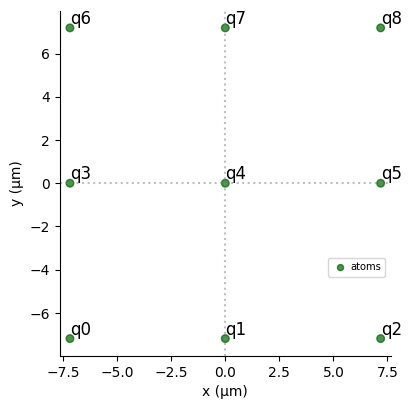
Creating my sequence
We compose our pulse with the following objects from Pulser:
[3]:
rise = Pulse.ConstantDetuning(
RampWaveform(t_rise, 0.0, Omega_max), delta_0, 0.0
)
sweep = Pulse.ConstantAmplitude(
Omega_max, RampWaveform(t_sweep, delta_0, delta_f), 0.0
)
fall = Pulse.ConstantDetuning(
RampWaveform(t_fall, Omega_max, 0.0), delta_f, 0.0
)
[4]:
seq = Sequence(reg, AnalogDevice)
seq.declare_channel("ising", "rydberg_global")
seq.add(rise, "ising")
seq.add(sweep, "ising")
seq.add(fall, "ising")
seq.draw()

Phase Diagram
The pulse sequence travels though the following path in the phase diagram of the system (the shaded area represents the antiferromagnetic phase):
[5]:
delta = []
omega = []
for x in seq._schedule["ising"]:
if isinstance(x.type, Pulse):
omega += list(x.type.amplitude.samples / U)
delta += list(x.type.detuning.samples / U)
fig, ax = plt.subplots()
ax.grid(True, which="both")
ax.set_ylabel(r"$\hbar\delta(t)/U$", fontsize=16)
ax.set_xlabel(r"$\hbar\Omega(t)/U$", fontsize=16)
ax.set_xlim(0, 3)
ax.axhline(y=0, color="k")
ax.axvline(x=0, color="k")
y = np.arange(0.0, 6, 0.01)
x = 1.522 * (1 - 0.25 * (y - 2) ** 2)
ax.fill_between(x, y, alpha=0.4)
ax.plot(omega, delta, "red", lw=2)
plt.show()
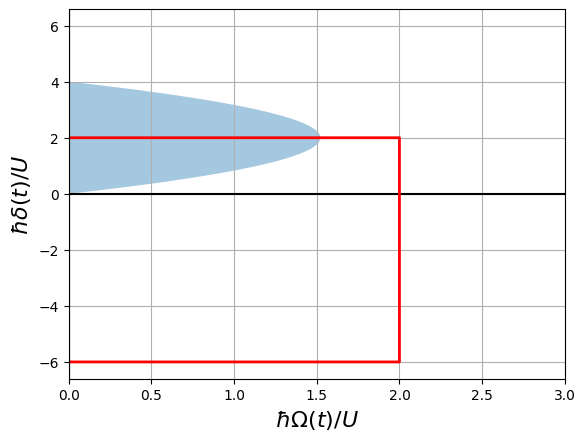
Simulation: Spin-Spin Correlation Function
We shall now evaluate the quality of the obtained state by calculating the spin-spin correlation function, defined as:
where the \(c\) indicates that we are calculating the connected part, and where the sum is over all pairs \((i,j)\) whose distance is \({\bf r}_i - {\bf r}_j = (k R,l R)\) in the atomic array coordinate (both \(k\) and \(l\) are positive or negative integers within the size of the array).
We run a simulation of the sequence:
[6]:
simul = QutipEmulator.from_sequence(seq, sampling_rate=0.02)
results = simul.run(progress_bar=True)
12.9%. Run time: 0.01s. Est. time left: 00:00:00:00
22.6%. Run time: 0.02s. Est. time left: 00:00:00:00
32.3%. Run time: 0.03s. Est. time left: 00:00:00:00
41.9%. Run time: 0.04s. Est. time left: 00:00:00:00
51.6%. Run time: 0.05s. Est. time left: 00:00:00:00
61.3%. Run time: 0.06s. Est. time left: 00:00:00:00
71.0%. Run time: 0.07s. Est. time left: 00:00:00:00
80.6%. Run time: 0.08s. Est. time left: 00:00:00:00
90.3%. Run time: 0.09s. Est. time left: 00:00:00:00
Total run time: 0.10s
Sample from final state using sample_final_state() method:
[7]:
count = results.sample_final_state()
most_freq = {k: v for k, v in count.items() if v > 10}
plt.bar(list(most_freq.keys()), list(most_freq.values()))
plt.xticks(rotation="vertical")
plt.show()
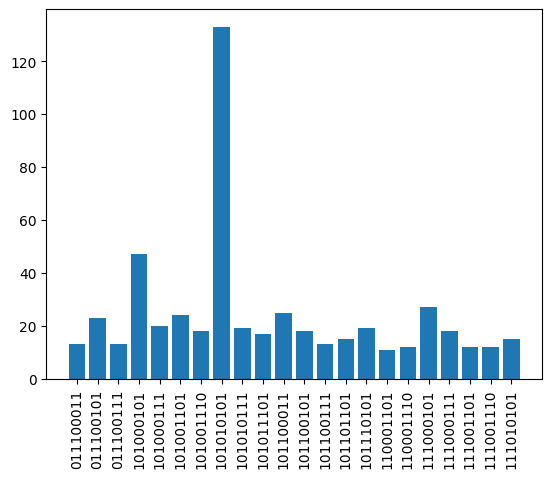
The observable to measure will be the occupation operator \(|r\rangle \langle r|_i\) on each site \(i\) of the register, where the Rydberg state \(|r\rangle\) represents the excited state.
[8]:
def occupation(j, N):
up = qutip.basis(2, 0)
prod = [qutip.qeye(2) for _ in range(N)]
prod[j] = up * up.dag()
return qutip.tensor(prod)
[9]:
occup_list = [occupation(j, N_side * N_side) for j in range(N_side * N_side)]
We define a function that returns all couples \((i,j)\) for a given \((k,l)\):
[10]:
def get_corr_pairs(k, l, register, R_interatomic):
corr_pairs = []
for i, qi in enumerate(register.qubits):
for j, qj in enumerate(register.qubits):
r_ij = register.qubits[qi] - register.qubits[qj]
distance = np.linalg.norm(r_ij - R_interatomic * np.array([k, l]))
if distance < 1:
corr_pairs.append([i, j])
return corr_pairs
The correlation function is calculated with the following routines:
[11]:
def get_corr_function(k, l, reg, R_interatomic, state):
N_qubits = len(reg.qubits)
corr_pairs = get_corr_pairs(k, l, reg, R_interatomic)
operators = [occupation(j, N_qubits) for j in range(N_qubits)]
covariance = 0
for qi, qj in corr_pairs:
covariance += qutip.expect(operators[qi] * operators[qj], state)
covariance -= qutip.expect(operators[qi], state) * qutip.expect(
operators[qj], state
)
return covariance / len(corr_pairs)
def get_full_corr_function(reg, state):
N_qubits = len(reg.qubits)
correlation_function = {}
N_side = int(np.sqrt(N_qubits))
for k in range(-N_side + 1, N_side):
for l in range(-N_side + 1, N_side):
correlation_function[(k, l)] = get_corr_function(
k, l, reg, R_interatomic, state
)
return correlation_function
With these functions, we operate on the final state of evolution obtained by our simulation.
[12]:
final = results.states[-1]
correlation_function = get_full_corr_function(reg, final)
[13]:
expected_corr_function = {}
xi = 1 # Estimated Correlation Length
for k in range(-N_side + 1, N_side):
for l in range(-N_side + 1, N_side):
kk = np.abs(k)
ll = np.abs(l)
expected_corr_function[(k, l)] = (-1) ** (kk + ll) * np.exp(
-np.sqrt(k**2 + l**2) / xi
)
[14]:
A = 4 * np.reshape(
list(correlation_function.values()), (2 * N_side - 1, 2 * N_side - 1)
)
A = A / np.max(A)
B = np.reshape(
list(expected_corr_function.values()), (2 * N_side - 1, 2 * N_side - 1)
)
B = B * np.max(A)
for i, M in enumerate([A.copy(), B.copy()]):
M[N_side - 1, N_side - 1] = None
plt.figure(figsize=(3.5, 3.5))
plt.imshow(M, cmap="coolwarm", vmin=-0.6, vmax=0.6)
plt.xticks(range(len(M)), [f"{x}" for x in range(-N_side + 1, N_side)])
plt.xlabel(r"$\mathscr{k}$", fontsize=22)
plt.yticks(range(len(M)), [f"{-y}" for y in range(-N_side + 1, N_side)])
plt.ylabel(r"$\mathscr{l}$", rotation=0, fontsize=22, labelpad=10)
plt.colorbar(fraction=0.047, pad=0.02)
if i == 0:
plt.title(
r"$4\times\.g^{(2)}(\mathscr{k},\mathscr{l})$ after simulation",
fontsize=14,
)
if i == 1:
plt.title(
r"Exponential $g^{(2)}(\mathscr{k},\mathscr{l})$ expected",
fontsize=14,
)
plt.show()
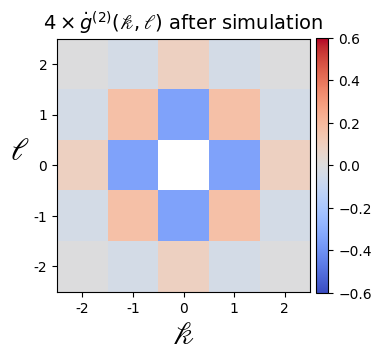
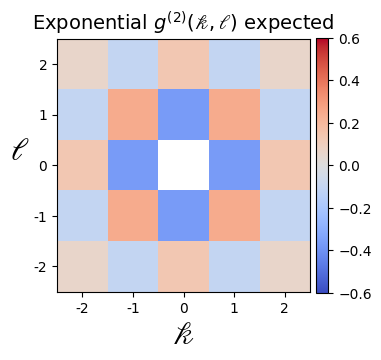
Note that the correlation function would follow an exponential decay (modulo finite-size effects), which is best observed at larger system sizes (see for example https://arxiv.org/pdf/2012.12268.pdf)
[15]:
np.around(A, 4)
[15]:
array([[-0.0039, -0.0385, 0.0866, -0.0385, -0.0039],
[-0.0385, 0.1654, -0.345 , 0.1654, -0.0385],
[ 0.0866, -0.345 , 1. , -0.345 , 0.0866],
[-0.0385, 0.1654, -0.345 , 0.1654, -0.0385],
[-0.0039, -0.0385, 0.0866, -0.0385, -0.0039]])
[16]:
np.around(B, 4)
[16]:
array([[ 0.0591, -0.1069, 0.1353, -0.1069, 0.0591],
[-0.1069, 0.2431, -0.3679, 0.2431, -0.1069],
[ 0.1353, -0.3679, 1. , -0.3679, 0.1353],
[-0.1069, 0.2431, -0.3679, 0.2431, -0.1069],
[ 0.0591, -0.1069, 0.1353, -0.1069, 0.0591]])
Néel Structure Factor
One way to explore the \(\Omega = 0\) line on the phase diagram is to calculate the Néel Structure Factor, \(S_{\text{Néel}}=4 \times \sum_{(k,l) \neq (0,0)} (-1)^{|k|+|l|} g^c(k,l)\), which should be highest when the state is more antiferromagnetic. We will sweep over different values of \(\delta_{\text{final}}\) to show that the region \(0<\hbar \delta_{\text{final}}/U<4\) is indeed where the antiferromagnetic phase takes place.
[17]:
def get_neel_structure_factor(reg, R_interatomic, state):
N_qubits = len(reg.qubits)
N_side = int(np.sqrt(N_qubits))
st_fac = 0
for k in range(-N_side + 1, N_side):
for l in range(-N_side + 1, N_side):
kk = np.abs(k)
ll = np.abs(l)
if not (k == 0 and l == 0):
st_fac += (
4
* (-1) ** (kk + ll)
* get_corr_function(k, l, reg, R_interatomic, state)
)
return st_fac
[18]:
def calculate_neel(det, N, Omega_max=2.0 * 2 * np.pi):
# Setup:
U = Omega_max / 2.0
delta_0 = -6 * U
delta_f = det * U
t_rise = 252
t_fall = 500
t_sweep = int((delta_f - delta_0) / (2 * np.pi * 10) * 1000)
t_sweep += (
4 - t_sweep % 4
) # To be a multiple of the clock period of AnalogDevice (4ns)
R_interatomic = AnalogDevice.rydberg_blockade_radius(U)
reg = Register.rectangle(N, N, R_interatomic)
# Pulse Sequence
rise = Pulse.ConstantDetuning(
RampWaveform(t_rise, 0.0, Omega_max), delta_0, 0.0
)
sweep = Pulse.ConstantAmplitude(
Omega_max, RampWaveform(t_sweep, delta_0, delta_f), 0.0
)
fall = Pulse.ConstantDetuning(
RampWaveform(t_fall, Omega_max, 0.0), delta_f, 0.0
)
seq = Sequence(reg, AnalogDevice)
seq.declare_channel("ising", "rydberg_global")
seq.add(rise, "ising")
seq.add(sweep, "ising")
seq.add(fall, "ising")
simul = QutipEmulator.from_sequence(seq, sampling_rate=0.2)
results = simul.run()
final = results.states[-1]
return get_neel_structure_factor(reg, R_interatomic, final)
[19]:
N_side = 3
occup_list = [occupation(j, N_side * N_side) for j in range(N_side * N_side)]
detunings = np.linspace(-1, 5, 20)
results = []
for det in detunings:
print(f"Detuning = {np.round(det,3)} x 2π Mhz.")
results.append(calculate_neel(det, N_side))
plt.xlabel(r"$\hbar\delta_{final}/U$")
plt.ylabel(r"Néel Structure Factor $S_{Neel}$")
plt.plot(detunings, results, "o", ls="solid")
plt.show()
max_index = results.index(max(results))
print(
f"Max S_Neel {np.round(max(results),2)} at detuning = {np.round(detunings[max_index],2)} x 2π Mhz."
)
Detuning = -1.0 x 2π Mhz.
Detuning = -0.684 x 2π Mhz.
Detuning = -0.368 x 2π Mhz.
Detuning = -0.053 x 2π Mhz.
Detuning = 0.263 x 2π Mhz.
Detuning = 0.579 x 2π Mhz.
Detuning = 0.895 x 2π Mhz.
Detuning = 1.211 x 2π Mhz.
Detuning = 1.526 x 2π Mhz.
Detuning = 1.842 x 2π Mhz.
Detuning = 2.158 x 2π Mhz.
Detuning = 2.474 x 2π Mhz.
Detuning = 2.789 x 2π Mhz.
Detuning = 3.105 x 2π Mhz.
Detuning = 3.421 x 2π Mhz.
Detuning = 3.737 x 2π Mhz.
Detuning = 4.053 x 2π Mhz.
Detuning = 4.368 x 2π Mhz.
Detuning = 4.684 x 2π Mhz.
Detuning = 5.0 x 2π Mhz.
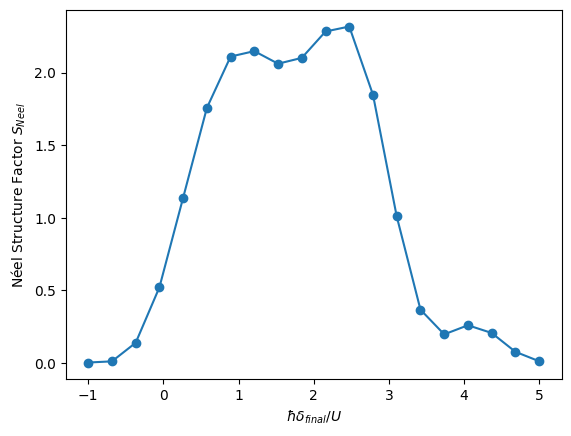
Max S_Neel 2.32 at detuning = 2.47 x 2π Mhz.